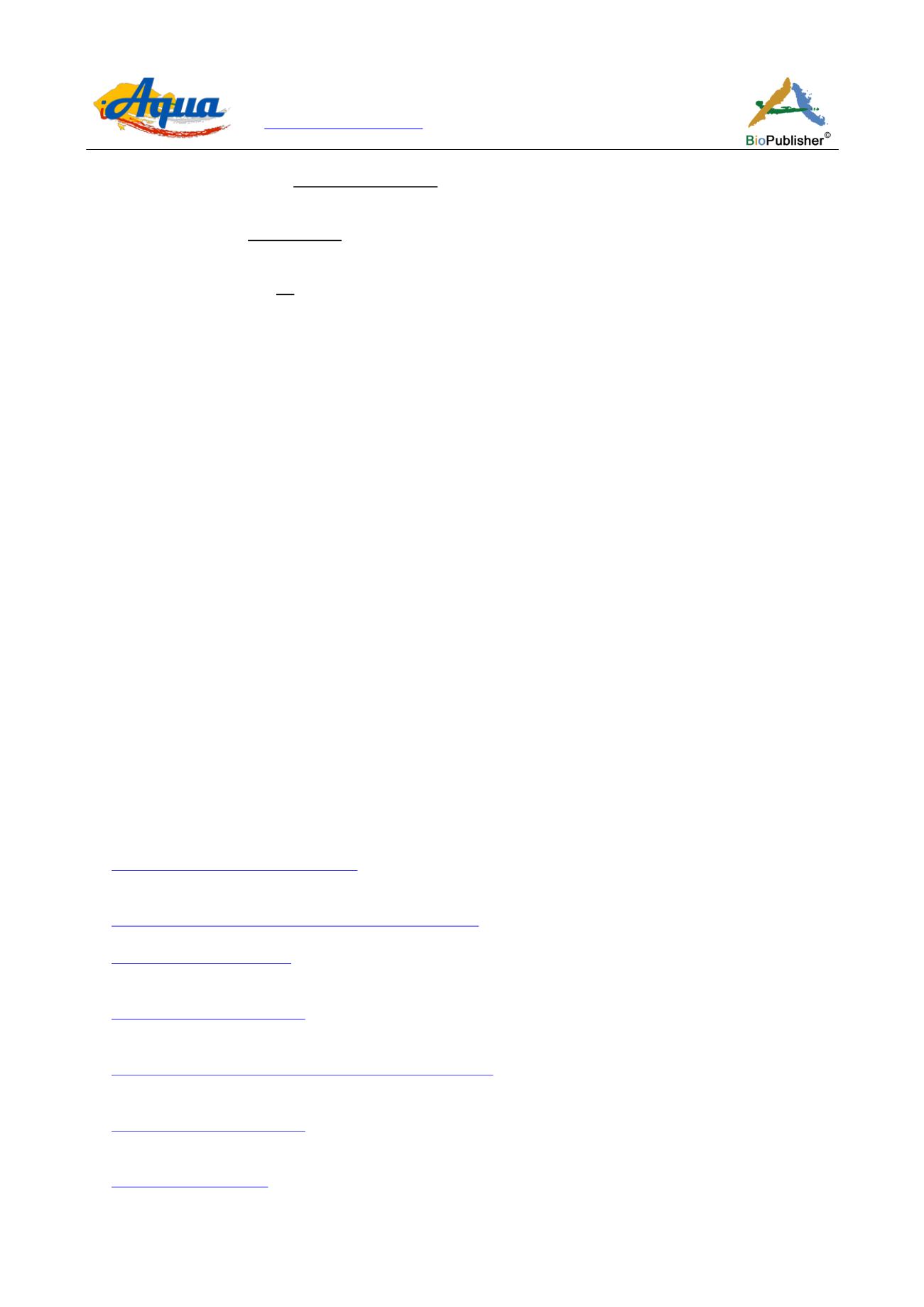
International Journal of Aquaculture, 2018, Vol.8, No.22, 161-167
165
Specific growth rate (SGR) =
ln(FMW) − ln(IMW)
T
× 100
Feed efficiency (FE) =
FB + DB − IB
dR
Consumption index (CI) =
1
FE
Where: FN = final fish number per pond, IN = initial fish number per pond, FB = final biomass per pond, Ln =
logarithm, T = time (experiment duration), DB = dead fish biomass (g), IB = initial biomass per pond (g), DR =
distributed ration (g).
3.3 Statistical analysis
Data collected during experiment were encoded in Excel software version 2010. Different zootechnical
parameters, physico-chemical and morpho-metrical were calculated. Mean and range of each parameter were
calculated and graphs were drawn. Statistical analyses were carried out by using STATVIEW software (version
5.01) at 5% probability threshold. A one way analysis of variance was carried out to compare zootechnical
performances of different treatments. In case of significant differences, the Fisher LSD (Least Significant
Difference) test served to means comparisons.
4 Conclusion
Fixing the optimum frequency of feeding, farmers can decrease the feed cost and increase growth parameters.
This study showed that the augmentation of feeding frequency above 3 times/day did not produce any significant
improvement of growth. Therefore, optimal feeding frequency for
Parachanna obscura
fingerlings reared in
controlled conditions is three times daily.
Authors’ contributions
All authors contributed equally in this study and writing of the manuscript. All authors read and approved the final manuscript.
Acknowledgements
This study was supported by the Ministry of Higher Education and Scientific Research of Republic of Benin.
References
Abid M., and Ahmed M.S., 2009, Efficacy of feeding frequency on growth and survival of
Labeorohita
(Ham) fingerlins under intensive rearing, Short
communication, J. Anim. Plant Sci., 19(2): 111-113
Aderolu A., Seriki B.M., Apatira A.L., and Ajaegbo C.U., 2010, Effects of feeding frequency on growth, feed efficiency and economic viability of rearing
African catfish (
Clarias gariepinus
, Burchell, 1822) fingerlins and juveniles, Afr. J. Food Sci., 4(5): 286-290
Alegria A., Barbera R., Farré R., Lagarda M.J., and Lopez J.C., 1999, Amino acid contents of infant formulas, J. Food COMPAnal, 12: 137-146
Ama-Abasi D., and Ogar A., 2013, Proximate analysis of snakehead fish,
Parachanna obscura
(Günther, 1861) of the cross river, Nigeria, J. Fish. Aquat. Sci.,
8(1): 295-298
Ashfauq F.A., Asha D., and Meera D.A., 2017, Efficacy of feeding frequency, feeding rates and formulated diets on growth and survival of rohu
Labeo rohita
brood stock under intensive rearing, International Journal of Fisheries and Aquatic Studies, 5(1): 85-89
Asuwaju F.P., Onyecha V.O., Ogbuebunu K.E., Moradum H.F., and Robert E.A., 2014, Effect of feeding frequency on growth and survival rate of
Clarias
gariepinus
fingerlings reared in plastic bowls, Journal of Fisheries and Aquatic Science, 9(5): 425-429
Bascinar N.E., Cakmak Y., and Cardar Aksunga N., 2007, The effect of feeding frequency on growth performance and feed conversion rate of black sea trout
(
Salmo trutta
, 1811), Turkish J. Fisheries and Aquatic Sci., 7: 13-17


